ARCH1024 - Melbourne Architecture: Rebellion and Pluralism Essay
VerifiedAdded on 2023/06/11
|13
|3989
|197
Essay
AI Summary
This essay explores expressionist tendencies in Australian architecture, particularly in Melbourne, focusing on the works of Edmond and Corrigan, Kevin Borland, and the Griffins. It examines their rebellion against mainstream architectural norms and their contributions to pluralism. The essay discusses Griffin's unique structures and design approaches, Edmond and Corrigan's use of polychrome brickwork, and the overall impact of these architects on the Australian architectural landscape. It also delves into the historical context, including the influence of European Modernism and the socio-political ideals that shaped their designs. The analysis includes specific examples of their works and the critical reception they received, highlighting their significance in the evolution of Australian architecture. Desklib provides a platform to access this essay along with numerous other solved assignments and study resources.
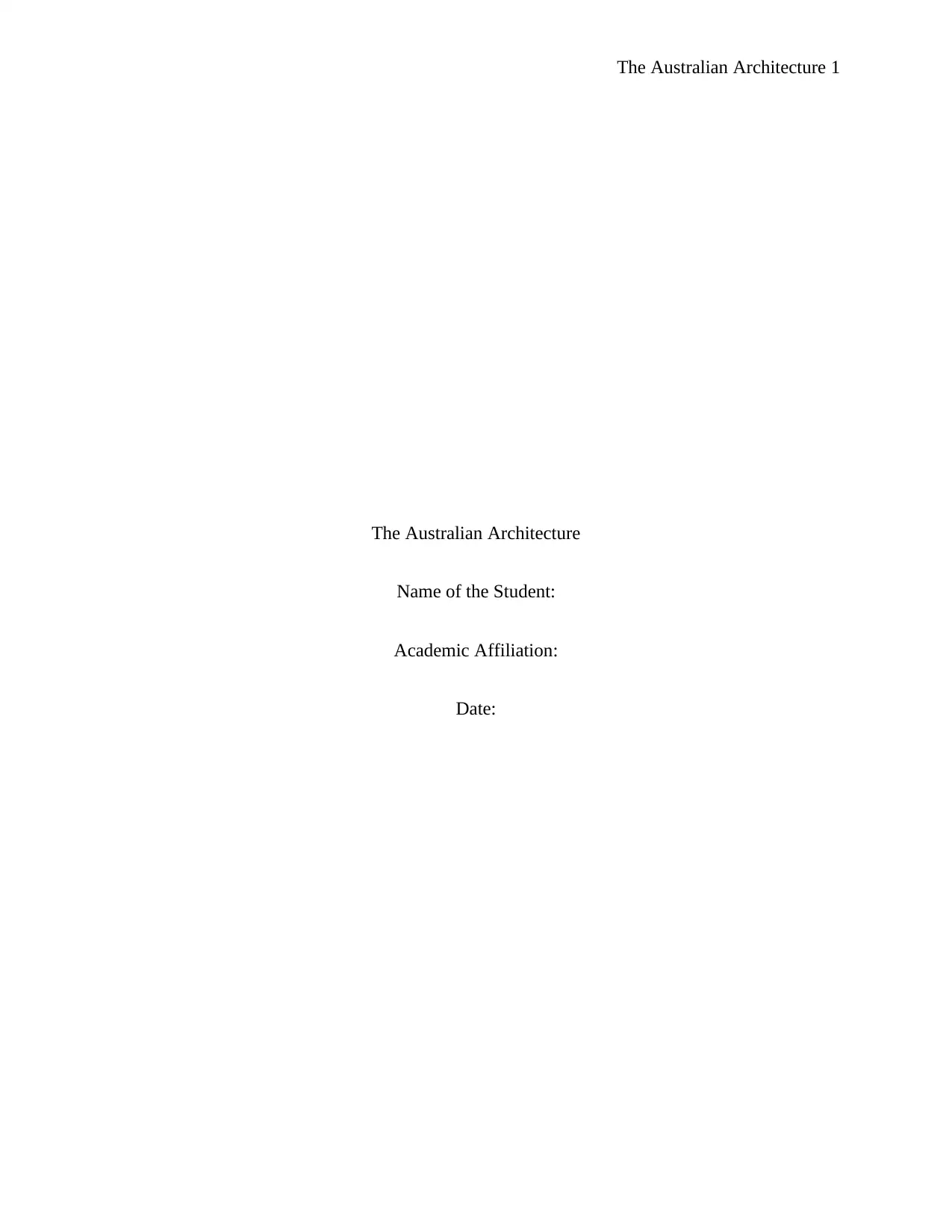
The Australian Architecture 1
The Australian Architecture
Name of the Student:
Academic Affiliation:
Date:
The Australian Architecture
Name of the Student:
Academic Affiliation:
Date:
Paraphrase This Document
Need a fresh take? Get an instant paraphrase of this document with our AI Paraphraser
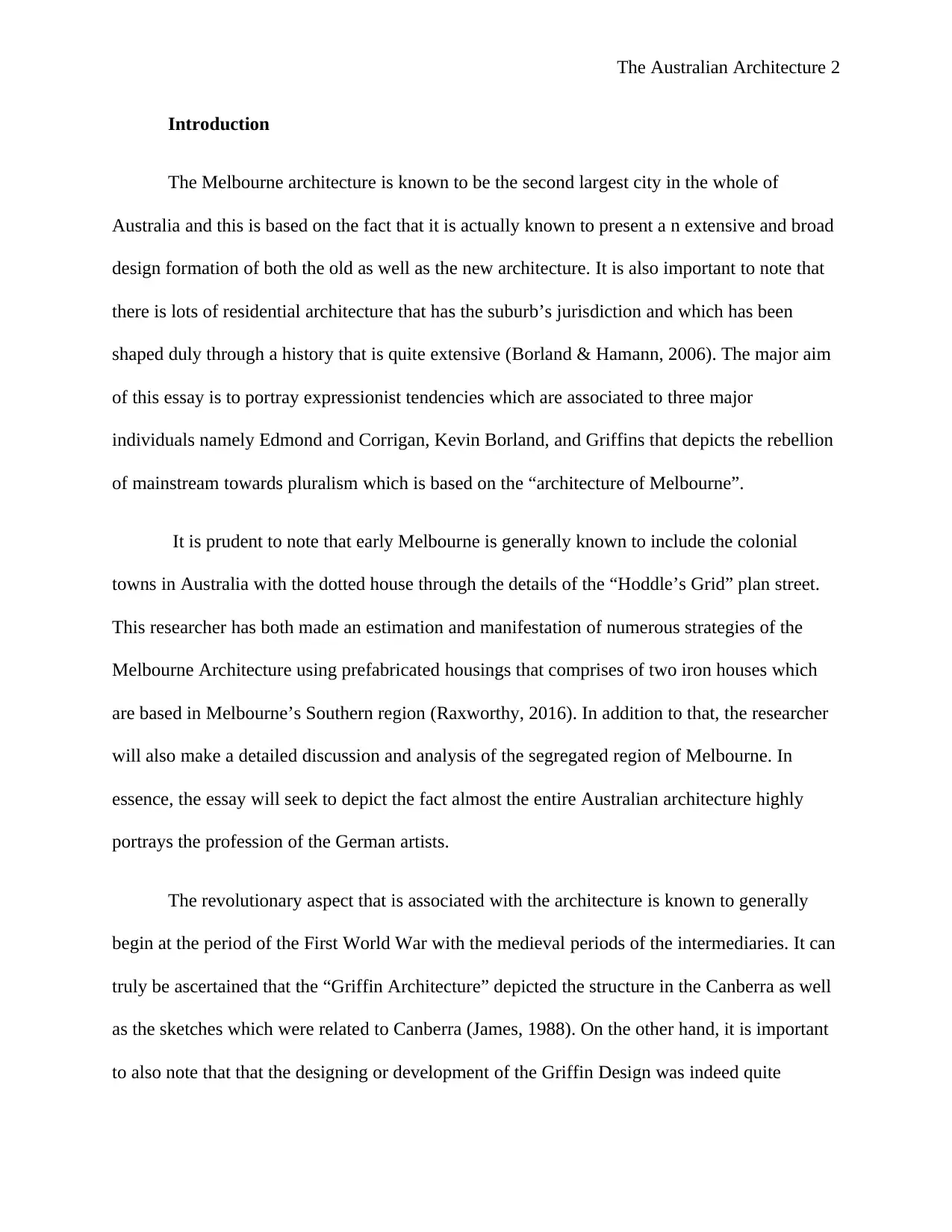
The Australian Architecture 2
Introduction
The Melbourne architecture is known to be the second largest city in the whole of
Australia and this is based on the fact that it is actually known to present a n extensive and broad
design formation of both the old as well as the new architecture. It is also important to note that
there is lots of residential architecture that has the suburb’s jurisdiction and which has been
shaped duly through a history that is quite extensive (Borland & Hamann, 2006). The major aim
of this essay is to portray expressionist tendencies which are associated to three major
individuals namely Edmond and Corrigan, Kevin Borland, and Griffins that depicts the rebellion
of mainstream towards pluralism which is based on the “architecture of Melbourne”.
It is prudent to note that early Melbourne is generally known to include the colonial
towns in Australia with the dotted house through the details of the “Hoddle’s Grid” plan street.
This researcher has both made an estimation and manifestation of numerous strategies of the
Melbourne Architecture using prefabricated housings that comprises of two iron houses which
are based in Melbourne’s Southern region (Raxworthy, 2016). In addition to that, the researcher
will also make a detailed discussion and analysis of the segregated region of Melbourne. In
essence, the essay will seek to depict the fact almost the entire Australian architecture highly
portrays the profession of the German artists.
The revolutionary aspect that is associated with the architecture is known to generally
begin at the period of the First World War with the medieval periods of the intermediaries. It can
truly be ascertained that the “Griffin Architecture” depicted the structure in the Canberra as well
as the sketches which were related to Canberra (James, 1988). On the other hand, it is important
to also note that that the designing or development of the Griffin Design was indeed quite
Introduction
The Melbourne architecture is known to be the second largest city in the whole of
Australia and this is based on the fact that it is actually known to present a n extensive and broad
design formation of both the old as well as the new architecture. It is also important to note that
there is lots of residential architecture that has the suburb’s jurisdiction and which has been
shaped duly through a history that is quite extensive (Borland & Hamann, 2006). The major aim
of this essay is to portray expressionist tendencies which are associated to three major
individuals namely Edmond and Corrigan, Kevin Borland, and Griffins that depicts the rebellion
of mainstream towards pluralism which is based on the “architecture of Melbourne”.
It is prudent to note that early Melbourne is generally known to include the colonial
towns in Australia with the dotted house through the details of the “Hoddle’s Grid” plan street.
This researcher has both made an estimation and manifestation of numerous strategies of the
Melbourne Architecture using prefabricated housings that comprises of two iron houses which
are based in Melbourne’s Southern region (Raxworthy, 2016). In addition to that, the researcher
will also make a detailed discussion and analysis of the segregated region of Melbourne. In
essence, the essay will seek to depict the fact almost the entire Australian architecture highly
portrays the profession of the German artists.
The revolutionary aspect that is associated with the architecture is known to generally
begin at the period of the First World War with the medieval periods of the intermediaries. It can
truly be ascertained that the “Griffin Architecture” depicted the structure in the Canberra as well
as the sketches which were related to Canberra (James, 1988). On the other hand, it is important
to also note that that the designing or development of the Griffin Design was indeed quite
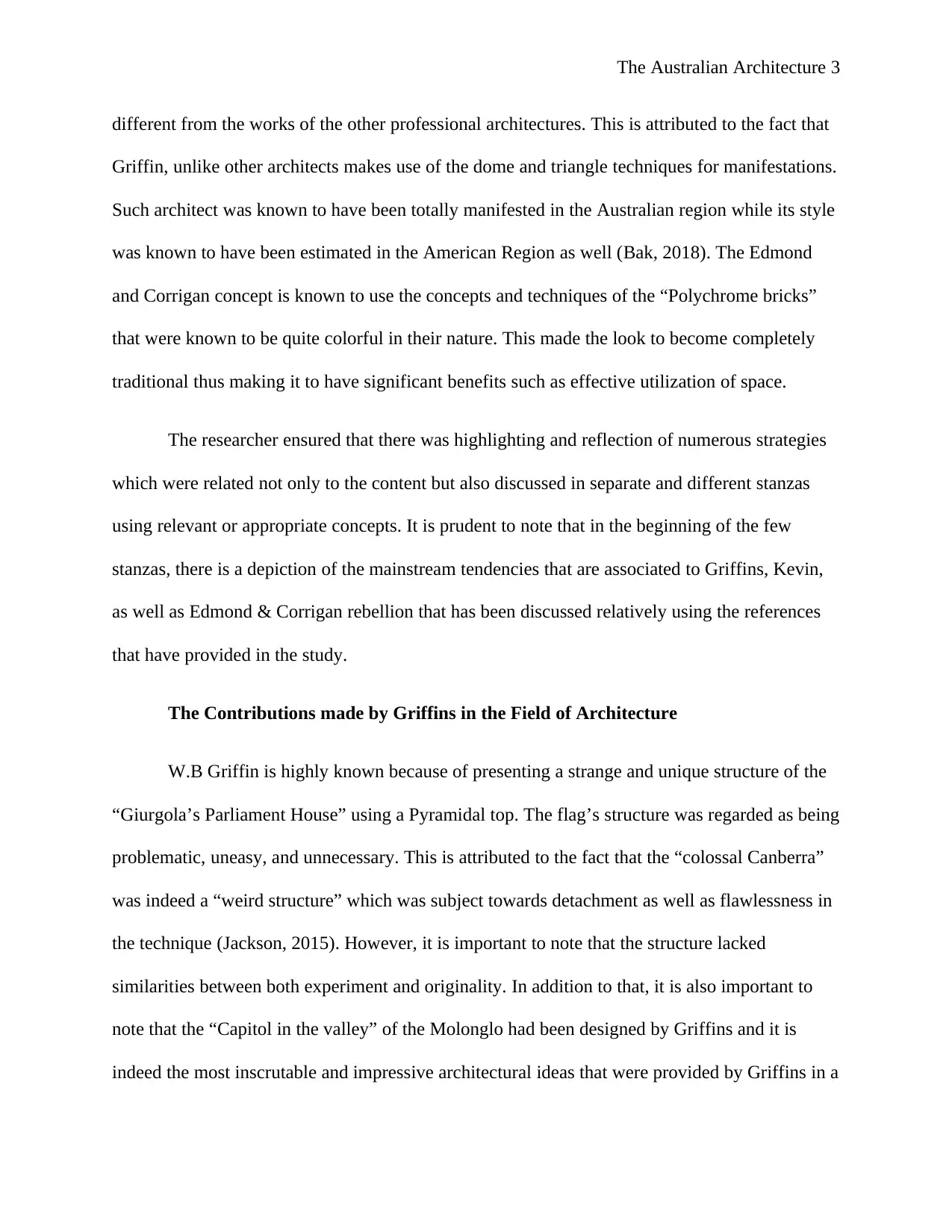
The Australian Architecture 3
different from the works of the other professional architectures. This is attributed to the fact that
Griffin, unlike other architects makes use of the dome and triangle techniques for manifestations.
Such architect was known to have been totally manifested in the Australian region while its style
was known to have been estimated in the American Region as well (Bak, 2018). The Edmond
and Corrigan concept is known to use the concepts and techniques of the “Polychrome bricks”
that were known to be quite colorful in their nature. This made the look to become completely
traditional thus making it to have significant benefits such as effective utilization of space.
The researcher ensured that there was highlighting and reflection of numerous strategies
which were related not only to the content but also discussed in separate and different stanzas
using relevant or appropriate concepts. It is prudent to note that in the beginning of the few
stanzas, there is a depiction of the mainstream tendencies that are associated to Griffins, Kevin,
as well as Edmond & Corrigan rebellion that has been discussed relatively using the references
that have provided in the study.
The Contributions made by Griffins in the Field of Architecture
W.B Griffin is highly known because of presenting a strange and unique structure of the
“Giurgola’s Parliament House” using a Pyramidal top. The flag’s structure was regarded as being
problematic, uneasy, and unnecessary. This is attributed to the fact that the “colossal Canberra”
was indeed a “weird structure” which was subject towards detachment as well as flawlessness in
the technique (Jackson, 2015). However, it is important to note that the structure lacked
similarities between both experiment and originality. In addition to that, it is also important to
note that the “Capitol in the valley” of the Molonglo had been designed by Griffins and it is
indeed the most inscrutable and impressive architectural ideas that were provided by Griffins in a
different from the works of the other professional architectures. This is attributed to the fact that
Griffin, unlike other architects makes use of the dome and triangle techniques for manifestations.
Such architect was known to have been totally manifested in the Australian region while its style
was known to have been estimated in the American Region as well (Bak, 2018). The Edmond
and Corrigan concept is known to use the concepts and techniques of the “Polychrome bricks”
that were known to be quite colorful in their nature. This made the look to become completely
traditional thus making it to have significant benefits such as effective utilization of space.
The researcher ensured that there was highlighting and reflection of numerous strategies
which were related not only to the content but also discussed in separate and different stanzas
using relevant or appropriate concepts. It is prudent to note that in the beginning of the few
stanzas, there is a depiction of the mainstream tendencies that are associated to Griffins, Kevin,
as well as Edmond & Corrigan rebellion that has been discussed relatively using the references
that have provided in the study.
The Contributions made by Griffins in the Field of Architecture
W.B Griffin is highly known because of presenting a strange and unique structure of the
“Giurgola’s Parliament House” using a Pyramidal top. The flag’s structure was regarded as being
problematic, uneasy, and unnecessary. This is attributed to the fact that the “colossal Canberra”
was indeed a “weird structure” which was subject towards detachment as well as flawlessness in
the technique (Jackson, 2015). However, it is important to note that the structure lacked
similarities between both experiment and originality. In addition to that, it is also important to
note that the “Capitol in the valley” of the Molonglo had been designed by Griffins and it is
indeed the most inscrutable and impressive architectural ideas that were provided by Griffins in a
⊘ This is a preview!⊘
Do you want full access?
Subscribe today to unlock all pages.

Trusted by 1+ million students worldwide
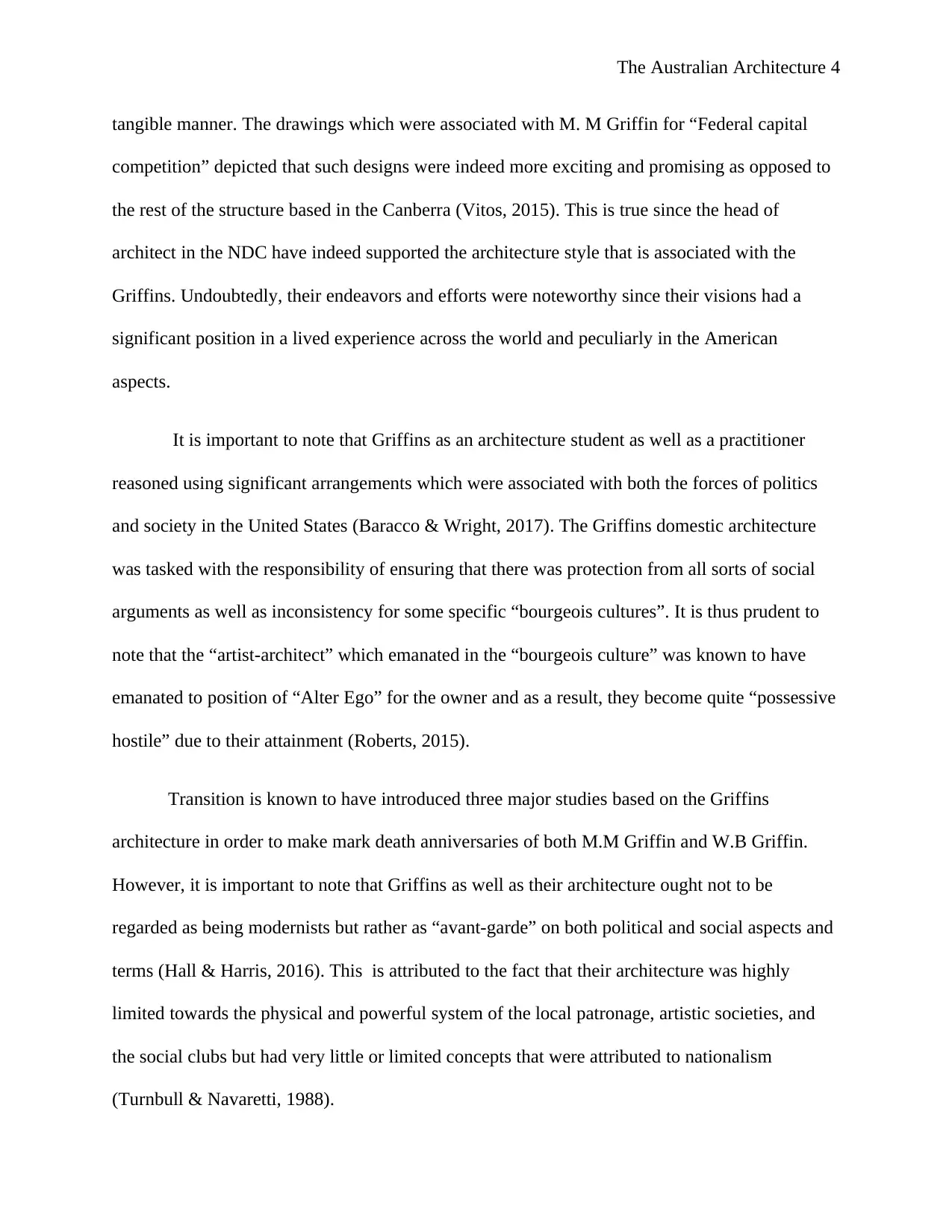
The Australian Architecture 4
tangible manner. The drawings which were associated with M. M Griffin for “Federal capital
competition” depicted that such designs were indeed more exciting and promising as opposed to
the rest of the structure based in the Canberra (Vitos, 2015). This is true since the head of
architect in the NDC have indeed supported the architecture style that is associated with the
Griffins. Undoubtedly, their endeavors and efforts were noteworthy since their visions had a
significant position in a lived experience across the world and peculiarly in the American
aspects.
It is important to note that Griffins as an architecture student as well as a practitioner
reasoned using significant arrangements which were associated with both the forces of politics
and society in the United States (Baracco & Wright, 2017). The Griffins domestic architecture
was tasked with the responsibility of ensuring that there was protection from all sorts of social
arguments as well as inconsistency for some specific “bourgeois cultures”. It is thus prudent to
note that the “artist-architect” which emanated in the “bourgeois culture” was known to have
emanated to position of “Alter Ego” for the owner and as a result, they become quite “possessive
hostile” due to their attainment (Roberts, 2015).
Transition is known to have introduced three major studies based on the Griffins
architecture in order to make mark death anniversaries of both M.M Griffin and W.B Griffin.
However, it is important to note that Griffins as well as their architecture ought not to be
regarded as being modernists but rather as “avant-garde” on both political and social aspects and
terms (Hall & Harris, 2016). This is attributed to the fact that their architecture was highly
limited towards the physical and powerful system of the local patronage, artistic societies, and
the social clubs but had very little or limited concepts that were attributed to nationalism
(Turnbull & Navaretti, 1988).
tangible manner. The drawings which were associated with M. M Griffin for “Federal capital
competition” depicted that such designs were indeed more exciting and promising as opposed to
the rest of the structure based in the Canberra (Vitos, 2015). This is true since the head of
architect in the NDC have indeed supported the architecture style that is associated with the
Griffins. Undoubtedly, their endeavors and efforts were noteworthy since their visions had a
significant position in a lived experience across the world and peculiarly in the American
aspects.
It is important to note that Griffins as an architecture student as well as a practitioner
reasoned using significant arrangements which were associated with both the forces of politics
and society in the United States (Baracco & Wright, 2017). The Griffins domestic architecture
was tasked with the responsibility of ensuring that there was protection from all sorts of social
arguments as well as inconsistency for some specific “bourgeois cultures”. It is thus prudent to
note that the “artist-architect” which emanated in the “bourgeois culture” was known to have
emanated to position of “Alter Ego” for the owner and as a result, they become quite “possessive
hostile” due to their attainment (Roberts, 2015).
Transition is known to have introduced three major studies based on the Griffins
architecture in order to make mark death anniversaries of both M.M Griffin and W.B Griffin.
However, it is important to note that Griffins as well as their architecture ought not to be
regarded as being modernists but rather as “avant-garde” on both political and social aspects and
terms (Hall & Harris, 2016). This is attributed to the fact that their architecture was highly
limited towards the physical and powerful system of the local patronage, artistic societies, and
the social clubs but had very little or limited concepts that were attributed to nationalism
(Turnbull & Navaretti, 1988).
Paraphrase This Document
Need a fresh take? Get an instant paraphrase of this document with our AI Paraphraser
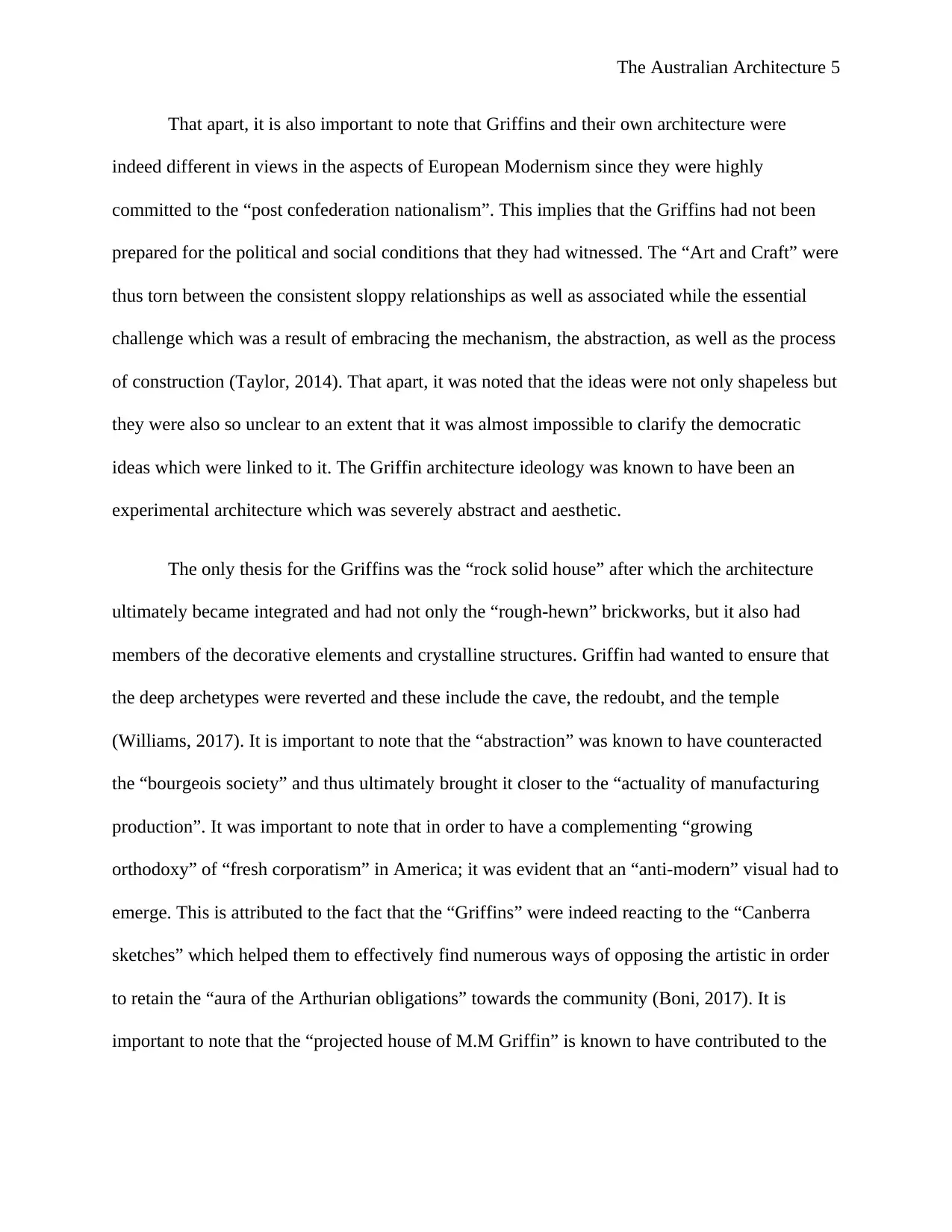
The Australian Architecture 5
That apart, it is also important to note that Griffins and their own architecture were
indeed different in views in the aspects of European Modernism since they were highly
committed to the “post confederation nationalism”. This implies that the Griffins had not been
prepared for the political and social conditions that they had witnessed. The “Art and Craft” were
thus torn between the consistent sloppy relationships as well as associated while the essential
challenge which was a result of embracing the mechanism, the abstraction, as well as the process
of construction (Taylor, 2014). That apart, it was noted that the ideas were not only shapeless but
they were also so unclear to an extent that it was almost impossible to clarify the democratic
ideas which were linked to it. The Griffin architecture ideology was known to have been an
experimental architecture which was severely abstract and aesthetic.
The only thesis for the Griffins was the “rock solid house” after which the architecture
ultimately became integrated and had not only the “rough-hewn” brickworks, but it also had
members of the decorative elements and crystalline structures. Griffin had wanted to ensure that
the deep archetypes were reverted and these include the cave, the redoubt, and the temple
(Williams, 2017). It is important to note that the “abstraction” was known to have counteracted
the “bourgeois society” and thus ultimately brought it closer to the “actuality of manufacturing
production”. It was important to note that in order to have a complementing “growing
orthodoxy” of “fresh corporatism” in America; it was evident that an “anti-modern” visual had to
emerge. This is attributed to the fact that the “Griffins” were indeed reacting to the “Canberra
sketches” which helped them to effectively find numerous ways of opposing the artistic in order
to retain the “aura of the Arthurian obligations” towards the community (Boni, 2017). It is
important to note that the “projected house of M.M Griffin” is known to have contributed to the
That apart, it is also important to note that Griffins and their own architecture were
indeed different in views in the aspects of European Modernism since they were highly
committed to the “post confederation nationalism”. This implies that the Griffins had not been
prepared for the political and social conditions that they had witnessed. The “Art and Craft” were
thus torn between the consistent sloppy relationships as well as associated while the essential
challenge which was a result of embracing the mechanism, the abstraction, as well as the process
of construction (Taylor, 2014). That apart, it was noted that the ideas were not only shapeless but
they were also so unclear to an extent that it was almost impossible to clarify the democratic
ideas which were linked to it. The Griffin architecture ideology was known to have been an
experimental architecture which was severely abstract and aesthetic.
The only thesis for the Griffins was the “rock solid house” after which the architecture
ultimately became integrated and had not only the “rough-hewn” brickworks, but it also had
members of the decorative elements and crystalline structures. Griffin had wanted to ensure that
the deep archetypes were reverted and these include the cave, the redoubt, and the temple
(Williams, 2017). It is important to note that the “abstraction” was known to have counteracted
the “bourgeois society” and thus ultimately brought it closer to the “actuality of manufacturing
production”. It was important to note that in order to have a complementing “growing
orthodoxy” of “fresh corporatism” in America; it was evident that an “anti-modern” visual had to
emerge. This is attributed to the fact that the “Griffins” were indeed reacting to the “Canberra
sketches” which helped them to effectively find numerous ways of opposing the artistic in order
to retain the “aura of the Arthurian obligations” towards the community (Boni, 2017). It is
important to note that the “projected house of M.M Griffin” is known to have contributed to the
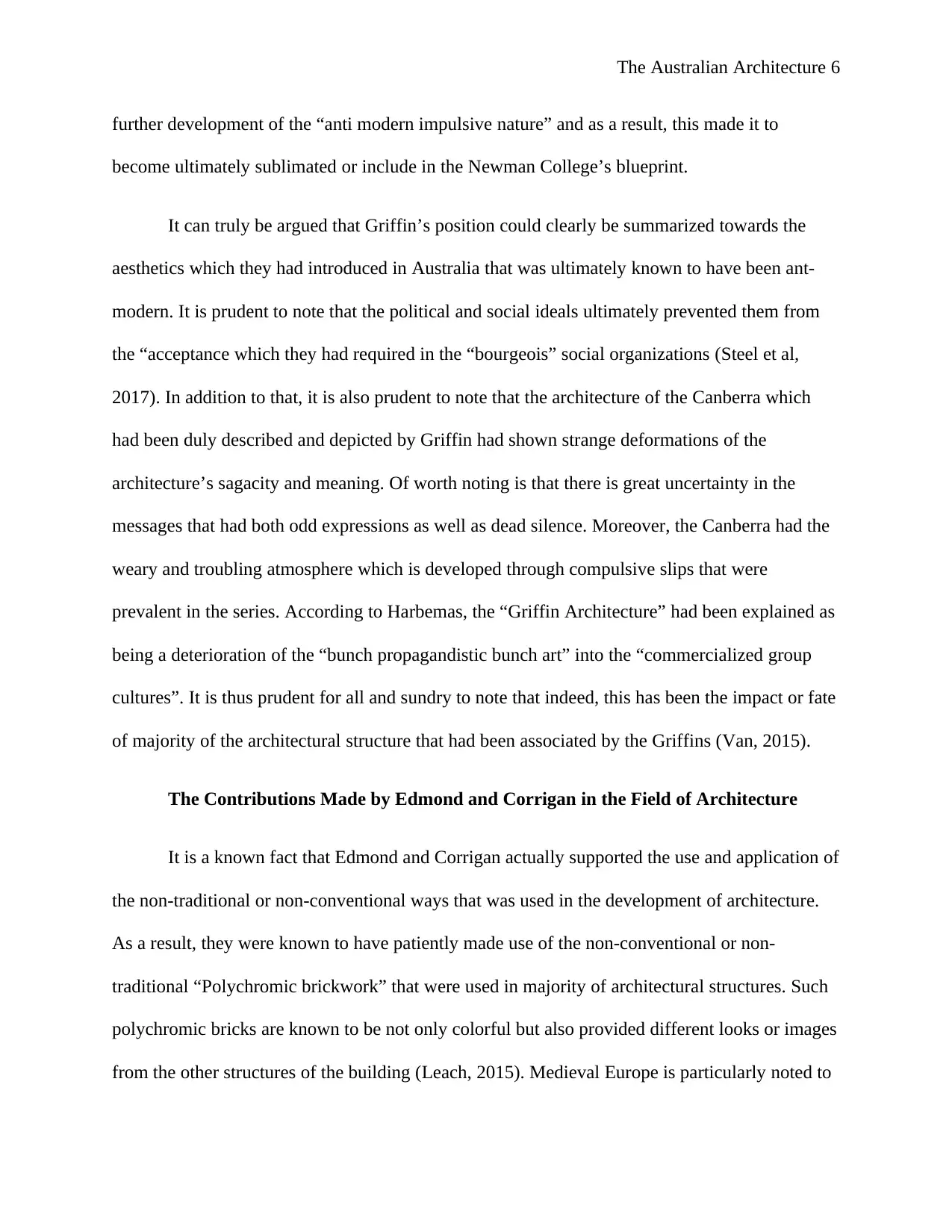
The Australian Architecture 6
further development of the “anti modern impulsive nature” and as a result, this made it to
become ultimately sublimated or include in the Newman College’s blueprint.
It can truly be argued that Griffin’s position could clearly be summarized towards the
aesthetics which they had introduced in Australia that was ultimately known to have been ant-
modern. It is prudent to note that the political and social ideals ultimately prevented them from
the “acceptance which they had required in the “bourgeois” social organizations (Steel et al,
2017). In addition to that, it is also prudent to note that the architecture of the Canberra which
had been duly described and depicted by Griffin had shown strange deformations of the
architecture’s sagacity and meaning. Of worth noting is that there is great uncertainty in the
messages that had both odd expressions as well as dead silence. Moreover, the Canberra had the
weary and troubling atmosphere which is developed through compulsive slips that were
prevalent in the series. According to Harbemas, the “Griffin Architecture” had been explained as
being a deterioration of the “bunch propagandistic bunch art” into the “commercialized group
cultures”. It is thus prudent for all and sundry to note that indeed, this has been the impact or fate
of majority of the architectural structure that had been associated by the Griffins (Van, 2015).
The Contributions Made by Edmond and Corrigan in the Field of Architecture
It is a known fact that Edmond and Corrigan actually supported the use and application of
the non-traditional or non-conventional ways that was used in the development of architecture.
As a result, they were known to have patiently made use of the non-conventional or non-
traditional “Polychromic brickwork” that were used in majority of architectural structures. Such
polychromic bricks are known to be not only colorful but also provided different looks or images
from the other structures of the building (Leach, 2015). Medieval Europe is particularly noted to
further development of the “anti modern impulsive nature” and as a result, this made it to
become ultimately sublimated or include in the Newman College’s blueprint.
It can truly be argued that Griffin’s position could clearly be summarized towards the
aesthetics which they had introduced in Australia that was ultimately known to have been ant-
modern. It is prudent to note that the political and social ideals ultimately prevented them from
the “acceptance which they had required in the “bourgeois” social organizations (Steel et al,
2017). In addition to that, it is also prudent to note that the architecture of the Canberra which
had been duly described and depicted by Griffin had shown strange deformations of the
architecture’s sagacity and meaning. Of worth noting is that there is great uncertainty in the
messages that had both odd expressions as well as dead silence. Moreover, the Canberra had the
weary and troubling atmosphere which is developed through compulsive slips that were
prevalent in the series. According to Harbemas, the “Griffin Architecture” had been explained as
being a deterioration of the “bunch propagandistic bunch art” into the “commercialized group
cultures”. It is thus prudent for all and sundry to note that indeed, this has been the impact or fate
of majority of the architectural structure that had been associated by the Griffins (Van, 2015).
The Contributions Made by Edmond and Corrigan in the Field of Architecture
It is a known fact that Edmond and Corrigan actually supported the use and application of
the non-traditional or non-conventional ways that was used in the development of architecture.
As a result, they were known to have patiently made use of the non-conventional or non-
traditional “Polychromic brickwork” that were used in majority of architectural structures. Such
polychromic bricks are known to be not only colorful but also provided different looks or images
from the other structures of the building (Leach, 2015). Medieval Europe is particularly noted to
⊘ This is a preview!⊘
Do you want full access?
Subscribe today to unlock all pages.

Trusted by 1+ million students worldwide
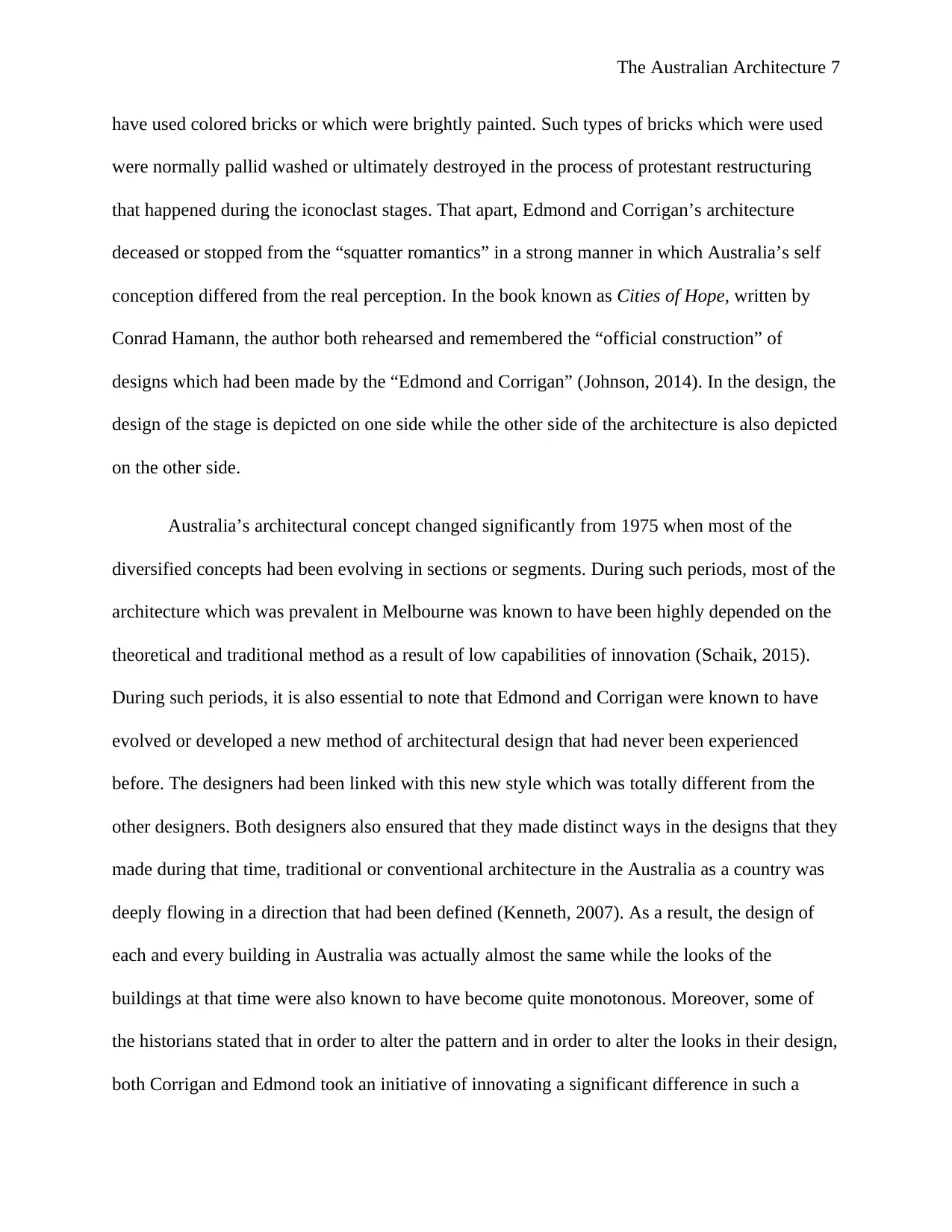
The Australian Architecture 7
have used colored bricks or which were brightly painted. Such types of bricks which were used
were normally pallid washed or ultimately destroyed in the process of protestant restructuring
that happened during the iconoclast stages. That apart, Edmond and Corrigan’s architecture
deceased or stopped from the “squatter romantics” in a strong manner in which Australia’s self
conception differed from the real perception. In the book known as Cities of Hope, written by
Conrad Hamann, the author both rehearsed and remembered the “official construction” of
designs which had been made by the “Edmond and Corrigan” (Johnson, 2014). In the design, the
design of the stage is depicted on one side while the other side of the architecture is also depicted
on the other side.
Australia’s architectural concept changed significantly from 1975 when most of the
diversified concepts had been evolving in sections or segments. During such periods, most of the
architecture which was prevalent in Melbourne was known to have been highly depended on the
theoretical and traditional method as a result of low capabilities of innovation (Schaik, 2015).
During such periods, it is also essential to note that Edmond and Corrigan were known to have
evolved or developed a new method of architectural design that had never been experienced
before. The designers had been linked with this new style which was totally different from the
other designers. Both designers also ensured that they made distinct ways in the designs that they
made during that time, traditional or conventional architecture in the Australia as a country was
deeply flowing in a direction that had been defined (Kenneth, 2007). As a result, the design of
each and every building in Australia was actually almost the same while the looks of the
buildings at that time were also known to have become quite monotonous. Moreover, some of
the historians stated that in order to alter the pattern and in order to alter the looks in their design,
both Corrigan and Edmond took an initiative of innovating a significant difference in such a
have used colored bricks or which were brightly painted. Such types of bricks which were used
were normally pallid washed or ultimately destroyed in the process of protestant restructuring
that happened during the iconoclast stages. That apart, Edmond and Corrigan’s architecture
deceased or stopped from the “squatter romantics” in a strong manner in which Australia’s self
conception differed from the real perception. In the book known as Cities of Hope, written by
Conrad Hamann, the author both rehearsed and remembered the “official construction” of
designs which had been made by the “Edmond and Corrigan” (Johnson, 2014). In the design, the
design of the stage is depicted on one side while the other side of the architecture is also depicted
on the other side.
Australia’s architectural concept changed significantly from 1975 when most of the
diversified concepts had been evolving in sections or segments. During such periods, most of the
architecture which was prevalent in Melbourne was known to have been highly depended on the
theoretical and traditional method as a result of low capabilities of innovation (Schaik, 2015).
During such periods, it is also essential to note that Edmond and Corrigan were known to have
evolved or developed a new method of architectural design that had never been experienced
before. The designers had been linked with this new style which was totally different from the
other designers. Both designers also ensured that they made distinct ways in the designs that they
made during that time, traditional or conventional architecture in the Australia as a country was
deeply flowing in a direction that had been defined (Kenneth, 2007). As a result, the design of
each and every building in Australia was actually almost the same while the looks of the
buildings at that time were also known to have become quite monotonous. Moreover, some of
the historians stated that in order to alter the pattern and in order to alter the looks in their design,
both Corrigan and Edmond took an initiative of innovating a significant difference in such a
Paraphrase This Document
Need a fresh take? Get an instant paraphrase of this document with our AI Paraphraser
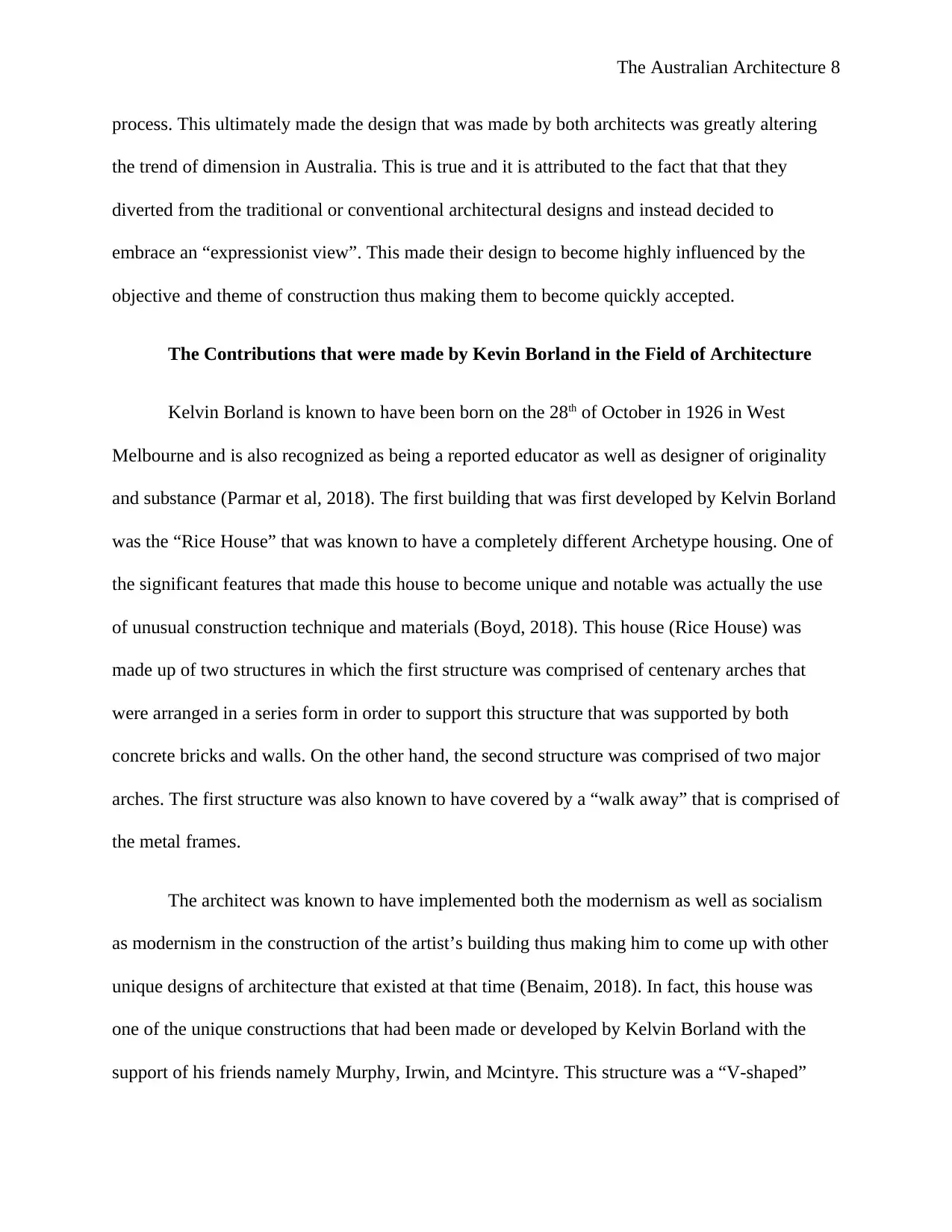
The Australian Architecture 8
process. This ultimately made the design that was made by both architects was greatly altering
the trend of dimension in Australia. This is true and it is attributed to the fact that that they
diverted from the traditional or conventional architectural designs and instead decided to
embrace an “expressionist view”. This made their design to become highly influenced by the
objective and theme of construction thus making them to become quickly accepted.
The Contributions that were made by Kevin Borland in the Field of Architecture
Kelvin Borland is known to have been born on the 28th of October in 1926 in West
Melbourne and is also recognized as being a reported educator as well as designer of originality
and substance (Parmar et al, 2018). The first building that was first developed by Kelvin Borland
was the “Rice House” that was known to have a completely different Archetype housing. One of
the significant features that made this house to become unique and notable was actually the use
of unusual construction technique and materials (Boyd, 2018). This house (Rice House) was
made up of two structures in which the first structure was comprised of centenary arches that
were arranged in a series form in order to support this structure that was supported by both
concrete bricks and walls. On the other hand, the second structure was comprised of two major
arches. The first structure was also known to have covered by a “walk away” that is comprised of
the metal frames.
The architect was known to have implemented both the modernism as well as socialism
as modernism in the construction of the artist’s building thus making him to come up with other
unique designs of architecture that existed at that time (Benaim, 2018). In fact, this house was
one of the unique constructions that had been made or developed by Kelvin Borland with the
support of his friends namely Murphy, Irwin, and Mcintyre. This structure was a “V-shaped”
process. This ultimately made the design that was made by both architects was greatly altering
the trend of dimension in Australia. This is true and it is attributed to the fact that that they
diverted from the traditional or conventional architectural designs and instead decided to
embrace an “expressionist view”. This made their design to become highly influenced by the
objective and theme of construction thus making them to become quickly accepted.
The Contributions that were made by Kevin Borland in the Field of Architecture
Kelvin Borland is known to have been born on the 28th of October in 1926 in West
Melbourne and is also recognized as being a reported educator as well as designer of originality
and substance (Parmar et al, 2018). The first building that was first developed by Kelvin Borland
was the “Rice House” that was known to have a completely different Archetype housing. One of
the significant features that made this house to become unique and notable was actually the use
of unusual construction technique and materials (Boyd, 2018). This house (Rice House) was
made up of two structures in which the first structure was comprised of centenary arches that
were arranged in a series form in order to support this structure that was supported by both
concrete bricks and walls. On the other hand, the second structure was comprised of two major
arches. The first structure was also known to have covered by a “walk away” that is comprised of
the metal frames.
The architect was known to have implemented both the modernism as well as socialism
as modernism in the construction of the artist’s building thus making him to come up with other
unique designs of architecture that existed at that time (Benaim, 2018). In fact, this house was
one of the unique constructions that had been made or developed by Kelvin Borland with the
support of his friends namely Murphy, Irwin, and Mcintyre. This structure was a “V-shaped”
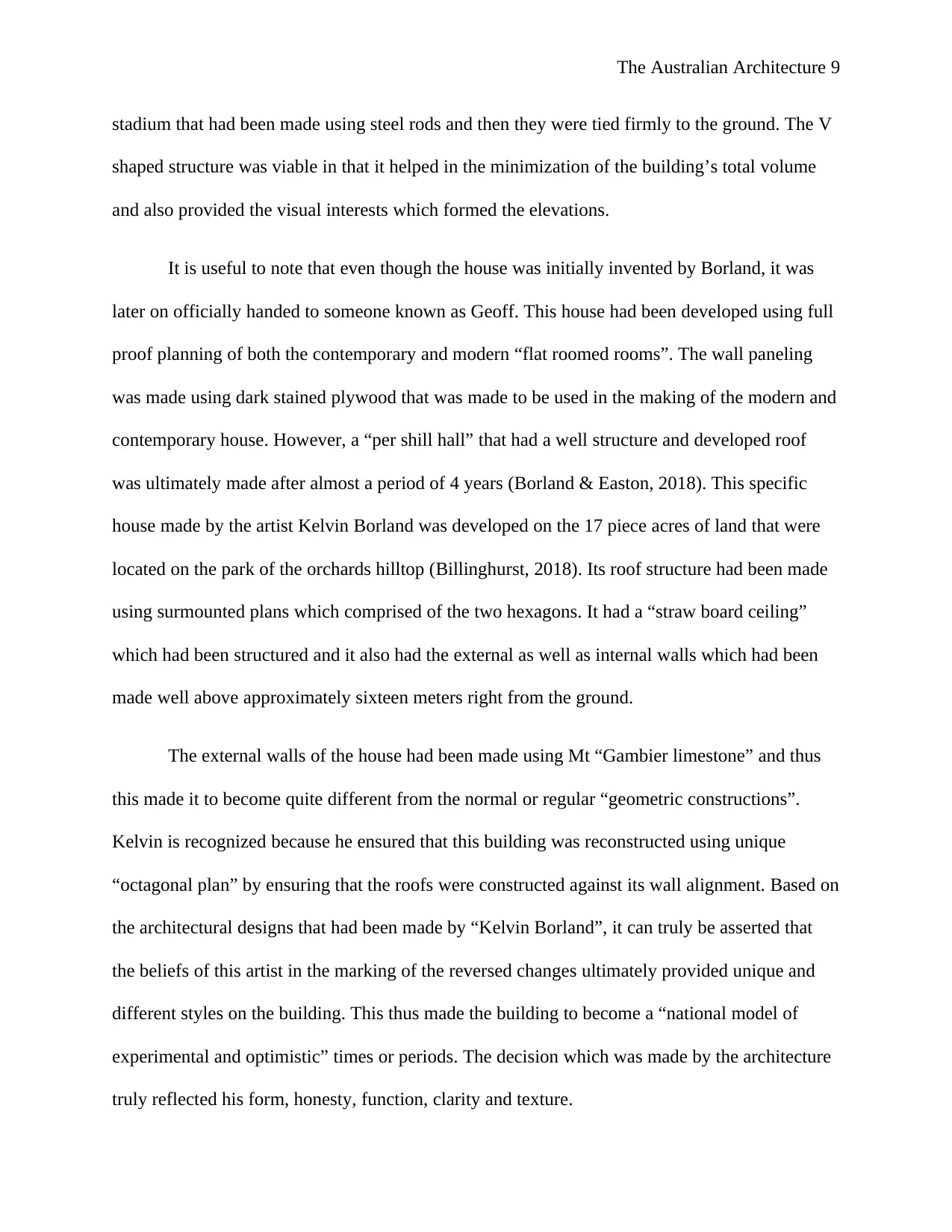
The Australian Architecture 9
stadium that had been made using steel rods and then they were tied firmly to the ground. The V
shaped structure was viable in that it helped in the minimization of the building’s total volume
and also provided the visual interests which formed the elevations.
It is useful to note that even though the house was initially invented by Borland, it was
later on officially handed to someone known as Geoff. This house had been developed using full
proof planning of both the contemporary and modern “flat roomed rooms”. The wall paneling
was made using dark stained plywood that was made to be used in the making of the modern and
contemporary house. However, a “per shill hall” that had a well structure and developed roof
was ultimately made after almost a period of 4 years (Borland & Easton, 2018). This specific
house made by the artist Kelvin Borland was developed on the 17 piece acres of land that were
located on the park of the orchards hilltop (Billinghurst, 2018). Its roof structure had been made
using surmounted plans which comprised of the two hexagons. It had a “straw board ceiling”
which had been structured and it also had the external as well as internal walls which had been
made well above approximately sixteen meters right from the ground.
The external walls of the house had been made using Mt “Gambier limestone” and thus
this made it to become quite different from the normal or regular “geometric constructions”.
Kelvin is recognized because he ensured that this building was reconstructed using unique
“octagonal plan” by ensuring that the roofs were constructed against its wall alignment. Based on
the architectural designs that had been made by “Kelvin Borland”, it can truly be asserted that
the beliefs of this artist in the marking of the reversed changes ultimately provided unique and
different styles on the building. This thus made the building to become a “national model of
experimental and optimistic” times or periods. The decision which was made by the architecture
truly reflected his form, honesty, function, clarity and texture.
stadium that had been made using steel rods and then they were tied firmly to the ground. The V
shaped structure was viable in that it helped in the minimization of the building’s total volume
and also provided the visual interests which formed the elevations.
It is useful to note that even though the house was initially invented by Borland, it was
later on officially handed to someone known as Geoff. This house had been developed using full
proof planning of both the contemporary and modern “flat roomed rooms”. The wall paneling
was made using dark stained plywood that was made to be used in the making of the modern and
contemporary house. However, a “per shill hall” that had a well structure and developed roof
was ultimately made after almost a period of 4 years (Borland & Easton, 2018). This specific
house made by the artist Kelvin Borland was developed on the 17 piece acres of land that were
located on the park of the orchards hilltop (Billinghurst, 2018). Its roof structure had been made
using surmounted plans which comprised of the two hexagons. It had a “straw board ceiling”
which had been structured and it also had the external as well as internal walls which had been
made well above approximately sixteen meters right from the ground.
The external walls of the house had been made using Mt “Gambier limestone” and thus
this made it to become quite different from the normal or regular “geometric constructions”.
Kelvin is recognized because he ensured that this building was reconstructed using unique
“octagonal plan” by ensuring that the roofs were constructed against its wall alignment. Based on
the architectural designs that had been made by “Kelvin Borland”, it can truly be asserted that
the beliefs of this artist in the marking of the reversed changes ultimately provided unique and
different styles on the building. This thus made the building to become a “national model of
experimental and optimistic” times or periods. The decision which was made by the architecture
truly reflected his form, honesty, function, clarity and texture.
⊘ This is a preview!⊘
Do you want full access?
Subscribe today to unlock all pages.

Trusted by 1+ million students worldwide
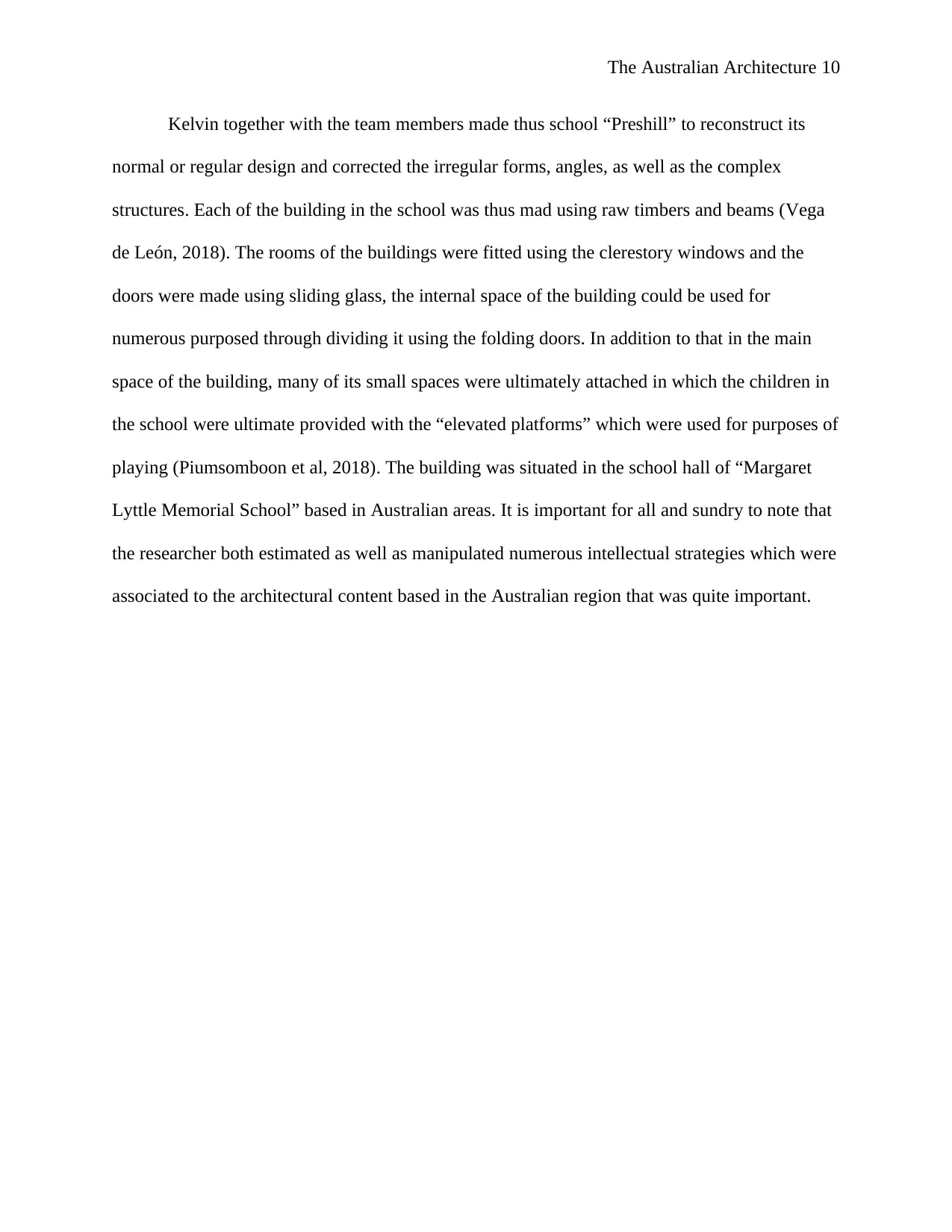
The Australian Architecture 10
Kelvin together with the team members made thus school “Preshill” to reconstruct its
normal or regular design and corrected the irregular forms, angles, as well as the complex
structures. Each of the building in the school was thus mad using raw timbers and beams (Vega
de León, 2018). The rooms of the buildings were fitted using the clerestory windows and the
doors were made using sliding glass, the internal space of the building could be used for
numerous purposed through dividing it using the folding doors. In addition to that in the main
space of the building, many of its small spaces were ultimately attached in which the children in
the school were ultimate provided with the “elevated platforms” which were used for purposes of
playing (Piumsomboon et al, 2018). The building was situated in the school hall of “Margaret
Lyttle Memorial School” based in Australian areas. It is important for all and sundry to note that
the researcher both estimated as well as manipulated numerous intellectual strategies which were
associated to the architectural content based in the Australian region that was quite important.
Kelvin together with the team members made thus school “Preshill” to reconstruct its
normal or regular design and corrected the irregular forms, angles, as well as the complex
structures. Each of the building in the school was thus mad using raw timbers and beams (Vega
de León, 2018). The rooms of the buildings were fitted using the clerestory windows and the
doors were made using sliding glass, the internal space of the building could be used for
numerous purposed through dividing it using the folding doors. In addition to that in the main
space of the building, many of its small spaces were ultimately attached in which the children in
the school were ultimate provided with the “elevated platforms” which were used for purposes of
playing (Piumsomboon et al, 2018). The building was situated in the school hall of “Margaret
Lyttle Memorial School” based in Australian areas. It is important for all and sundry to note that
the researcher both estimated as well as manipulated numerous intellectual strategies which were
associated to the architectural content based in the Australian region that was quite important.
Paraphrase This Document
Need a fresh take? Get an instant paraphrase of this document with our AI Paraphraser
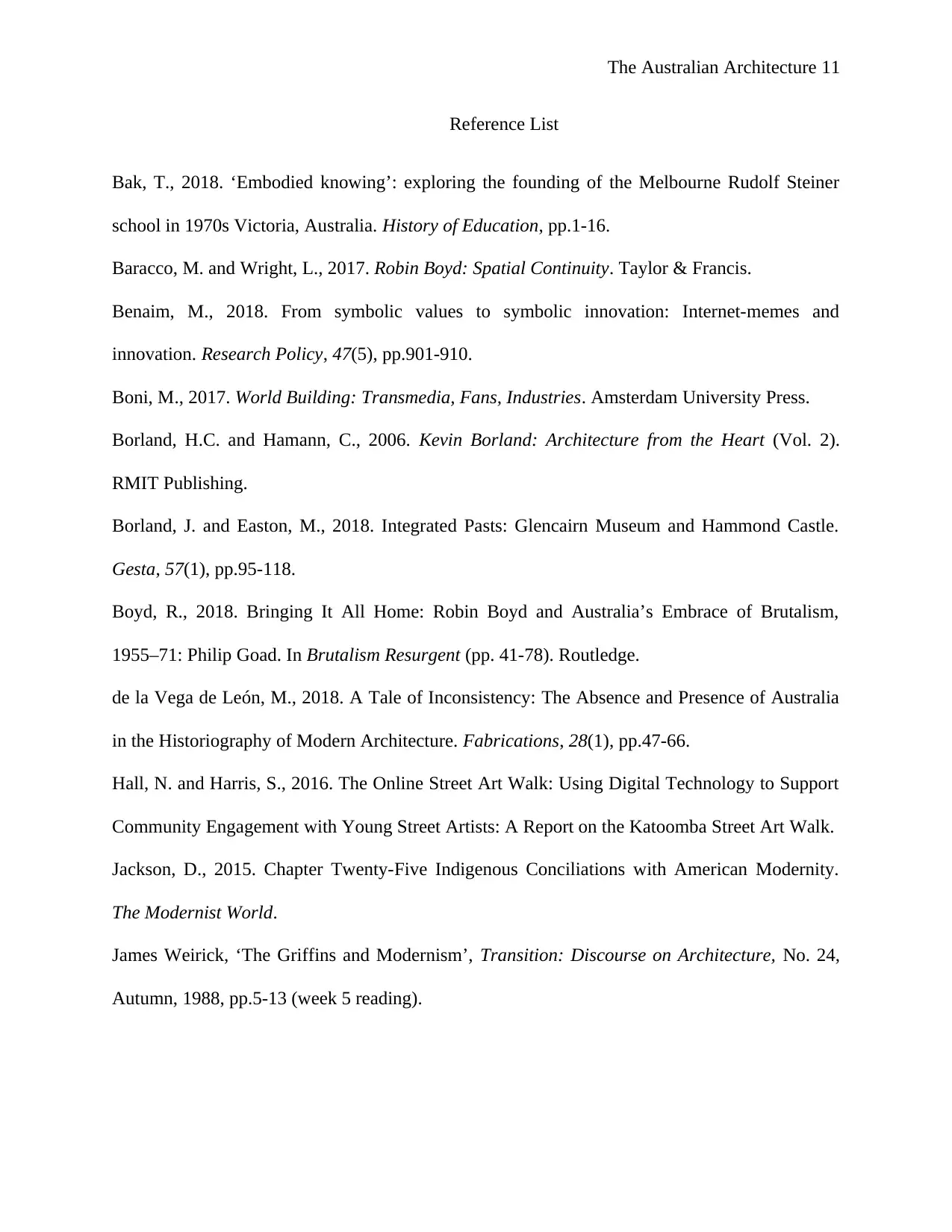
The Australian Architecture 11
Reference List
Bak, T., 2018. ‘Embodied knowing’: exploring the founding of the Melbourne Rudolf Steiner
school in 1970s Victoria, Australia. History of Education, pp.1-16.
Baracco, M. and Wright, L., 2017. Robin Boyd: Spatial Continuity. Taylor & Francis.
Benaim, M., 2018. From symbolic values to symbolic innovation: Internet-memes and
innovation. Research Policy, 47(5), pp.901-910.
Boni, M., 2017. World Building: Transmedia, Fans, Industries. Amsterdam University Press.
Borland, H.C. and Hamann, C., 2006. Kevin Borland: Architecture from the Heart (Vol. 2).
RMIT Publishing.
Borland, J. and Easton, M., 2018. Integrated Pasts: Glencairn Museum and Hammond Castle.
Gesta, 57(1), pp.95-118.
Boyd, R., 2018. Bringing It All Home: Robin Boyd and Australia’s Embrace of Brutalism,
1955–71: Philip Goad. In Brutalism Resurgent (pp. 41-78). Routledge.
de la Vega de León, M., 2018. A Tale of Inconsistency: The Absence and Presence of Australia
in the Historiography of Modern Architecture. Fabrications, 28(1), pp.47-66.
Hall, N. and Harris, S., 2016. The Online Street Art Walk: Using Digital Technology to Support
Community Engagement with Young Street Artists: A Report on the Katoomba Street Art Walk.
Jackson, D., 2015. Chapter Twenty-Five Indigenous Conciliations with American Modernity.
The Modernist World.
James Weirick, ‘The Griffins and Modernism’, Transition: Discourse on Architecture, No. 24,
Autumn, 1988, pp.5-13 (week 5 reading).
Reference List
Bak, T., 2018. ‘Embodied knowing’: exploring the founding of the Melbourne Rudolf Steiner
school in 1970s Victoria, Australia. History of Education, pp.1-16.
Baracco, M. and Wright, L., 2017. Robin Boyd: Spatial Continuity. Taylor & Francis.
Benaim, M., 2018. From symbolic values to symbolic innovation: Internet-memes and
innovation. Research Policy, 47(5), pp.901-910.
Boni, M., 2017. World Building: Transmedia, Fans, Industries. Amsterdam University Press.
Borland, H.C. and Hamann, C., 2006. Kevin Borland: Architecture from the Heart (Vol. 2).
RMIT Publishing.
Borland, J. and Easton, M., 2018. Integrated Pasts: Glencairn Museum and Hammond Castle.
Gesta, 57(1), pp.95-118.
Boyd, R., 2018. Bringing It All Home: Robin Boyd and Australia’s Embrace of Brutalism,
1955–71: Philip Goad. In Brutalism Resurgent (pp. 41-78). Routledge.
de la Vega de León, M., 2018. A Tale of Inconsistency: The Absence and Presence of Australia
in the Historiography of Modern Architecture. Fabrications, 28(1), pp.47-66.
Hall, N. and Harris, S., 2016. The Online Street Art Walk: Using Digital Technology to Support
Community Engagement with Young Street Artists: A Report on the Katoomba Street Art Walk.
Jackson, D., 2015. Chapter Twenty-Five Indigenous Conciliations with American Modernity.
The Modernist World.
James Weirick, ‘The Griffins and Modernism’, Transition: Discourse on Architecture, No. 24,
Autumn, 1988, pp.5-13 (week 5 reading).
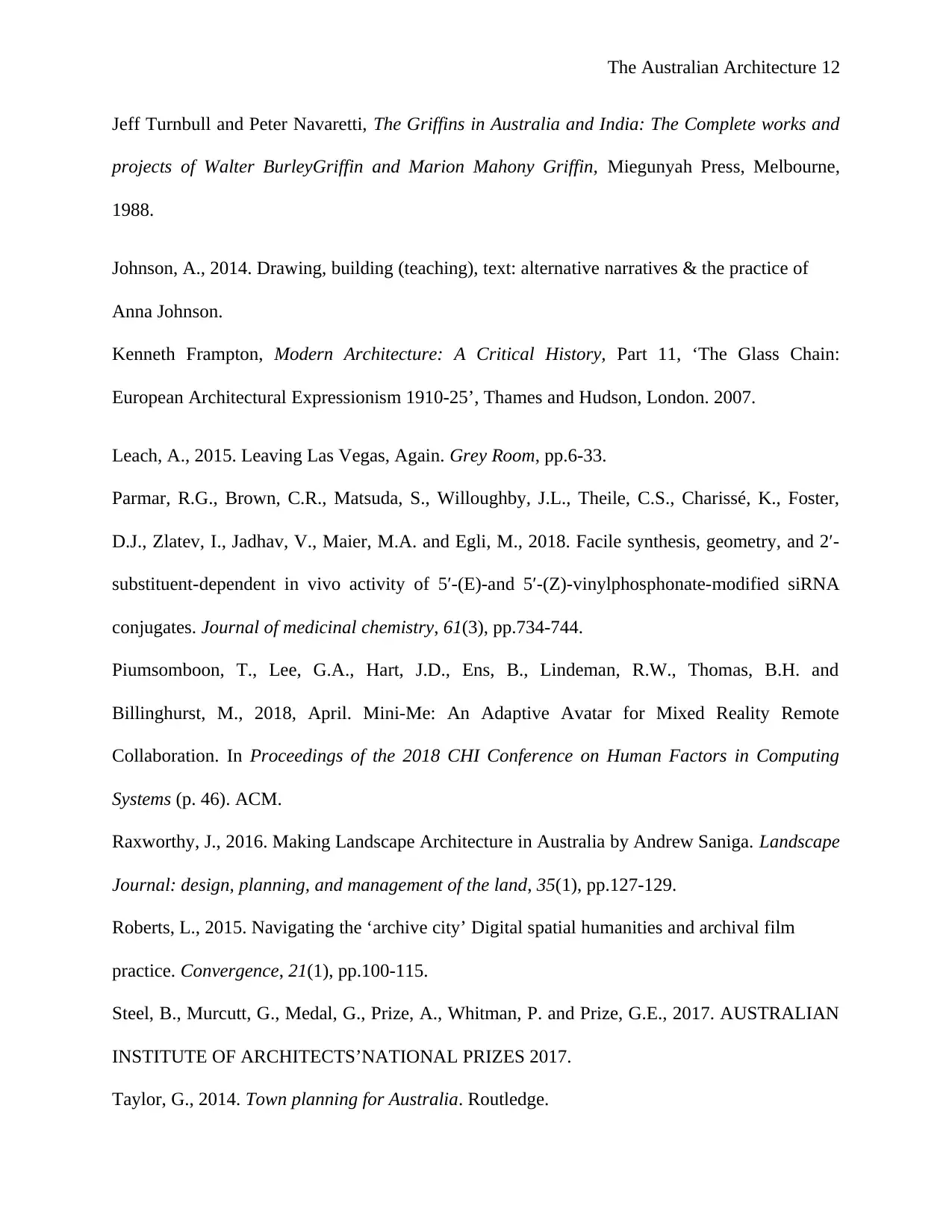
The Australian Architecture 12
Jeff Turnbull and Peter Navaretti, The Griffins in Australia and India: The Complete works and
projects of Walter BurleyGriffin and Marion Mahony Griffin, Miegunyah Press, Melbourne,
1988.
Johnson, A., 2014. Drawing, building (teaching), text: alternative narratives & the practice of
Anna Johnson.
Kenneth Frampton, Modern Architecture: A Critical History, Part 11, ‘The Glass Chain:
European Architectural Expressionism 1910-25’, Thames and Hudson, London. 2007.
Leach, A., 2015. Leaving Las Vegas, Again. Grey Room, pp.6-33.
Parmar, R.G., Brown, C.R., Matsuda, S., Willoughby, J.L., Theile, C.S., Charissé, K., Foster,
D.J., Zlatev, I., Jadhav, V., Maier, M.A. and Egli, M., 2018. Facile synthesis, geometry, and 2′-
substituent-dependent in vivo activity of 5′-(E)-and 5′-(Z)-vinylphosphonate-modified siRNA
conjugates. Journal of medicinal chemistry, 61(3), pp.734-744.
Piumsomboon, T., Lee, G.A., Hart, J.D., Ens, B., Lindeman, R.W., Thomas, B.H. and
Billinghurst, M., 2018, April. Mini-Me: An Adaptive Avatar for Mixed Reality Remote
Collaboration. In Proceedings of the 2018 CHI Conference on Human Factors in Computing
Systems (p. 46). ACM.
Raxworthy, J., 2016. Making Landscape Architecture in Australia by Andrew Saniga. Landscape
Journal: design, planning, and management of the land, 35(1), pp.127-129.
Roberts, L., 2015. Navigating the ‘archive city’ Digital spatial humanities and archival film
practice. Convergence, 21(1), pp.100-115.
Steel, B., Murcutt, G., Medal, G., Prize, A., Whitman, P. and Prize, G.E., 2017. AUSTRALIAN
INSTITUTE OF ARCHITECTS’NATIONAL PRIZES 2017.
Taylor, G., 2014. Town planning for Australia. Routledge.
Jeff Turnbull and Peter Navaretti, The Griffins in Australia and India: The Complete works and
projects of Walter BurleyGriffin and Marion Mahony Griffin, Miegunyah Press, Melbourne,
1988.
Johnson, A., 2014. Drawing, building (teaching), text: alternative narratives & the practice of
Anna Johnson.
Kenneth Frampton, Modern Architecture: A Critical History, Part 11, ‘The Glass Chain:
European Architectural Expressionism 1910-25’, Thames and Hudson, London. 2007.
Leach, A., 2015. Leaving Las Vegas, Again. Grey Room, pp.6-33.
Parmar, R.G., Brown, C.R., Matsuda, S., Willoughby, J.L., Theile, C.S., Charissé, K., Foster,
D.J., Zlatev, I., Jadhav, V., Maier, M.A. and Egli, M., 2018. Facile synthesis, geometry, and 2′-
substituent-dependent in vivo activity of 5′-(E)-and 5′-(Z)-vinylphosphonate-modified siRNA
conjugates. Journal of medicinal chemistry, 61(3), pp.734-744.
Piumsomboon, T., Lee, G.A., Hart, J.D., Ens, B., Lindeman, R.W., Thomas, B.H. and
Billinghurst, M., 2018, April. Mini-Me: An Adaptive Avatar for Mixed Reality Remote
Collaboration. In Proceedings of the 2018 CHI Conference on Human Factors in Computing
Systems (p. 46). ACM.
Raxworthy, J., 2016. Making Landscape Architecture in Australia by Andrew Saniga. Landscape
Journal: design, planning, and management of the land, 35(1), pp.127-129.
Roberts, L., 2015. Navigating the ‘archive city’ Digital spatial humanities and archival film
practice. Convergence, 21(1), pp.100-115.
Steel, B., Murcutt, G., Medal, G., Prize, A., Whitman, P. and Prize, G.E., 2017. AUSTRALIAN
INSTITUTE OF ARCHITECTS’NATIONAL PRIZES 2017.
Taylor, G., 2014. Town planning for Australia. Routledge.
⊘ This is a preview!⊘
Do you want full access?
Subscribe today to unlock all pages.

Trusted by 1+ million students worldwide
1 out of 13
Your All-in-One AI-Powered Toolkit for Academic Success.
+13062052269
info@desklib.com
Available 24*7 on WhatsApp / Email
![[object Object]](/_next/static/media/star-bottom.7253800d.svg)
Unlock your academic potential
Copyright © 2020–2025 A2Z Services. All Rights Reserved. Developed and managed by ZUCOL.
